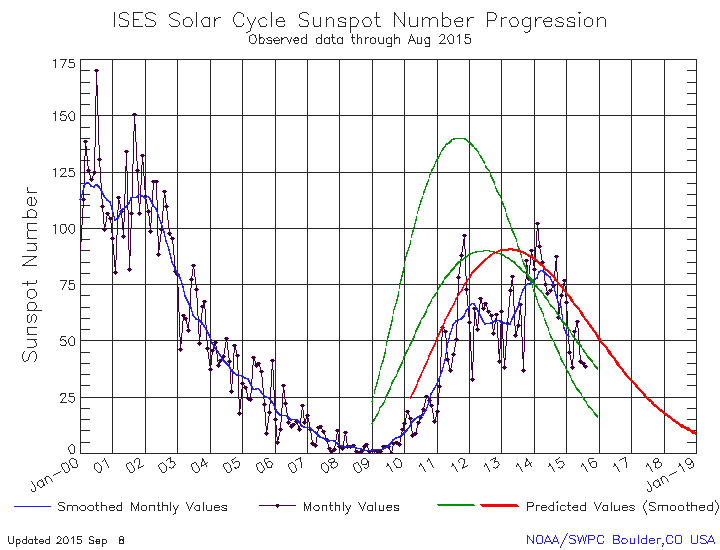Decline to solar minimum
Last week NOAA posted its monthly update of the solar cycle, showing the Sun’s sunspot activity in August. As I have done every month since 2010, I am posting it here, below the fold, with annotations to give it context.
The sunspot count continued its decline, though dropping only a small amount. Regardless, the decline continues at a rate far faster than predicted or is usual during the ramp down from solar maximum. If this rate of decline should continue, we will reach solar minimum sometime late in 2017, two years earlier than predicted (as indicated by the red curve).

The graph above has been modified to show the predictions of the solar science community. The green curves show the community’s two original predictions from April 2007, with half the scientists predicting a very strong maximum and half predicting a weak one. The red curve is their revised May 2009 prediction.
I would be surprised if this happens however. More likely we will continue to see the sunspot count go through fits and starts for the next few years so that we do not reach minimum until 2018. This will still be faster than predicted, once again indicating the weak nature of this solar cycle.
What will be scientifically interesting in the coming years will be two things: 1. How the sun behaves as it ramps down from this unusually weak maximum, and 2. How will our climate respond. We now have the tools to study both with much greater accuracy than in any previous time, and thus we will be able to see how closely these two phenomenon are linked.
On Christmas Eve 1968 three Americans became the first humans to visit another world. What they did to celebrate was unexpected and profound, and will be remembered throughout all human history. Genesis: the Story of Apollo 8, Robert Zimmerman's classic history of humanity's first journey to another world, tells that story, and it is now available as both an ebook and an audiobook, both with a foreword by Valerie Anders and a new introduction by Robert Zimmerman.
The ebook is available everywhere for $5.99 (before discount) at amazon, or direct from my ebook publisher, ebookit. If you buy it from ebookit you don't support the big tech companies and the author gets a bigger cut much sooner.
The audiobook is also available at all these vendors, and is also free with a 30-day trial membership to Audible.
"Not simply about one mission, [Genesis] is also the history of America's quest for the moon... Zimmerman has done a masterful job of tying disparate events together into a solid account of one of America's greatest human triumphs."--San Antonio Express-News


The prediction from 2009 was really great! Although it is an unusual change in cycle characteristic. And I think they were talking about a broadening double top too. The magics of heliophycisists.
How many indexes are available now from the Solar Dynamics Observatory and how does one get a graph similar to the one Bob listed in this article? How far back in time can we go and can we accurate climate data? I guess one could draw down the temperature data for various cities and work from there, but why invent the wheel if it is already done?
You might want to do a search on BtB for “sunspots” or “solar cycle”. My monthly posts on this subject since 2010 contain a lot of information and background links which could answer most of your questions.